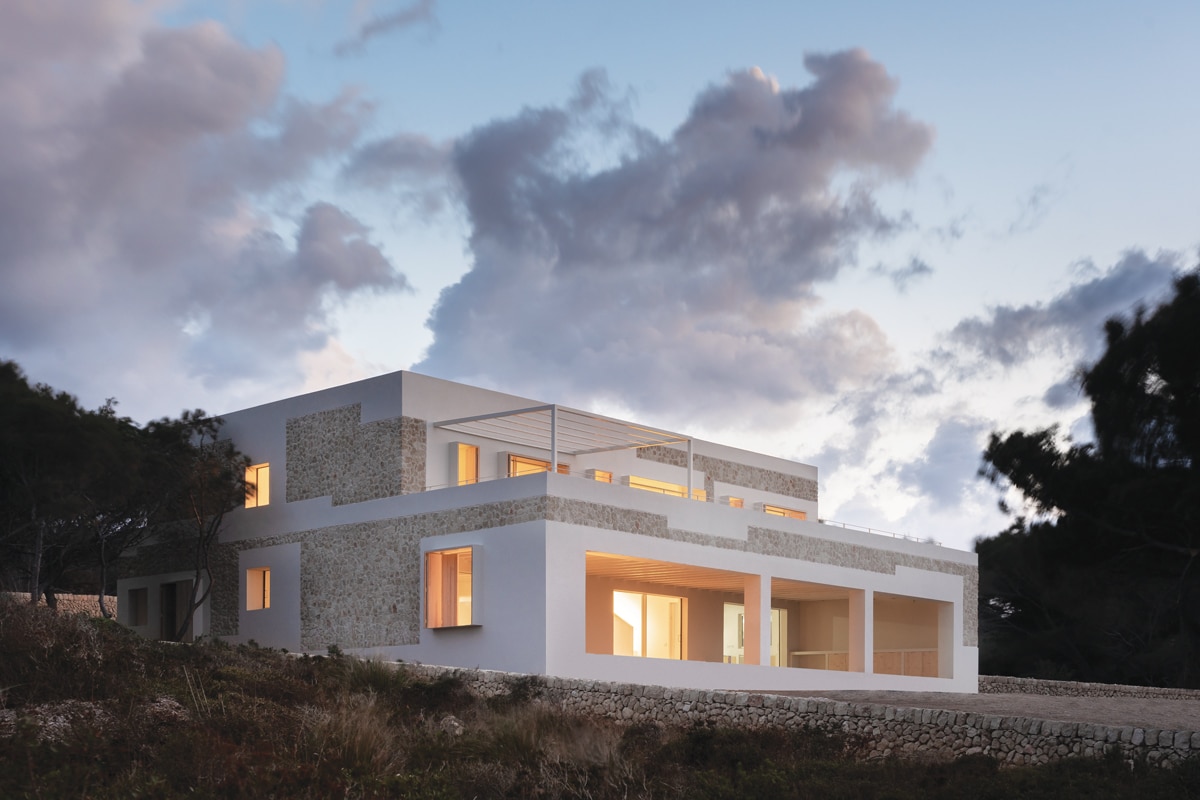Story at a glance:
- Modern stone homes often feature stone siding due to the high cost of materials and labor of solid stone walls.
- Stone homes are extremely durable, relatively easy to maintain, help regulate temperature, and last for generations.
- Architectural stone veneer can be a lighter and more cost effective alternative to natural stone siding, though it may not last as long.
Stone homes are among the oldest structures ever built by humans, and with good reason; stone is one of the most durable building materials there is, capable of weathering all sorts of climatic events.
We often associate stone homes with antiquity and the rural countryside or northern coastline, but the truth is stone has remained popular throughout the course of history and is still a part of our contemporary world. It is this versatility, alongside stone’s durability, resilience, strength, and longevity, that allows stone homes to evolve and find its niche in any time period, as we’ll see below.
What is a Stone Home?

The NOMO-designed Stone House in Minorca, Spain. Photo courtesy of Joan Guillamat
In the conventional sense, a stone home is any dwelling that primarily features stone in its construction. Traditionally stone homes were built using locally sourced stones, either in their natural shape or cut into blocks or slabs. These stones were then stacked and mortared in staggered rows atop a foundation to form solid, load-bearing walls capable of supporting what was usually a timber roof.
Today true stone homes aren’t built with the frequency they once were. Due to the high cost of materials and labor associated with stone construction, new solid-stone homes are typically only constructed by the wealthy—or by homesteaders who skirt the costs by gathering the stone and performing the construction themselves.
Most modern homes that incorporate stone do so via a layer of stone siding or natural stone panels rather than solid stone walls, but the possibilities are many. “In the past few years this building material [stone] experienced a renaissance,” Tolga Altug, product and sourcing manager at Materials Marketing, previously told gb&d. “The special feature of stone is its versatility, which makes every surface—be it a facade, roof, or floor—unique and offers architects and builders countless design options.”
Pros & Cons of Stone Homes
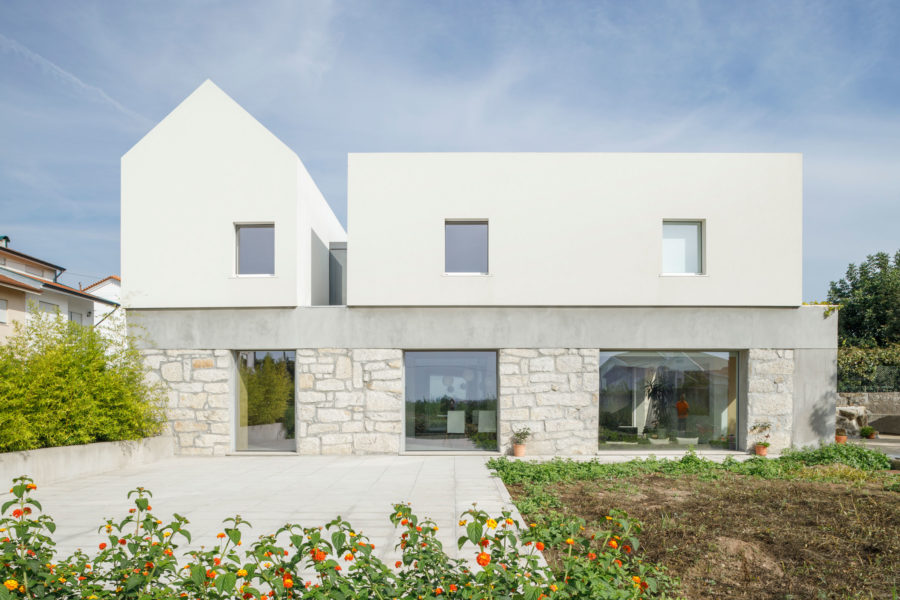
Photo by Ivo Tavares Studio
Like all houses, stone homes have their fair share of both advantages and disadvantages that can make or break the decision to buy or build one. Here are some of the pros and cons of designing or building a stone home.
Advantages
Generally speaking, the benefits of stone homes significantly outweigh their disadvantages—something that should come as no surprise given their everlasting popularity.
Extremely Durable
First and foremost stone homes—especially those with solid stone walls—are incredibly durable structures capable of lasting hundreds (and even thousands) of years.
This is because, in its natural state, stone is both fireproof, pest-resistant, rot-resistant, and is able to weather wind, rain, and snow with minimal wear. “Various limestones, marble, and granite have been made by nature millions of years ago and, when used in construction, will last as long as the underlying structure lasts,” Hugo Vega, Polycor’s vice president of commercial and institutional sales, previously told gb&d.
High Thermal Mass
Unlike something such as timber (which is highly insulative), stone has a high thermal mass—this means stone is capable of absorbing heat, storing it, and then releasing it over an extended period of time. Materials with a high thermal mass are well suited for use in projects looking to implement passive solar design strategies.
As long as a stone home is properly insulated and maintained, this high thermal mass will help keep interior temperatures cooler in the summer and allow the walls to retain heat in the winter, reducing the energy expenditure required for heating and cooling.
Stone’s ability to help regulate interior temperatures was one of several reasons why Paulo Merlini Architects decided to retain Casa Rio’s original granite walls when redesigning and expanding the Portuguese home.
Versatility
When it comes to construction materials, few are as versatile as stone. “Natural stone is very versatile. It offers a wider range of sizes and formats and a multitude of styles that concrete and other cast products can’t,” Vega says. Available in a range of forms, shapes, and colors, natural stone has the potential for inclusion in just about any architectural project—and not just as structural support, but as intentional aesthetic enhancement or stylistic choice.
“When people think about natural stone they think about old buildings, but natural stone can also meet the design needs of modern architecture and aesthetics,” Jean-Francois Marquis, communications director at Polycor, previously told gb&d.
Limestone, sandstone, quartzite, and granite are often used as large blocks or bricks to construct walls, though they can also be used as siding. Stones like marble or travertine may be used to construct pillars and columns or used as an accent material. Stone can even be used in roofing. Slate is commonly used to tile roofs due to it’s high durability.
Disadvantages
Stone homes aren’t perfect, but for the most part flaws can be avoided or cons are worth it in the long run.
Initial Cost
Regardless of whether you’re building a home with solid stone walls or if you’re just installing natural stone siding, the upfront material and labor costs will be significantly higher than those associated with building a timber, wooden frame, adobe, brick, or even concrete home. One of the only ways to avoid these initial costs is to gather the stone yourself, either from the project site or neighboring areas, and performing the construction on your own.
The high upfront costs of stone homes are almost always justified by their incredible durability and extremely long lifespans.
Weight
There’s no two ways about it: Stone is heavy. And while the weight of stone helps make it durable, it can also pose a few challenges when it comes to constructing stone dwellings, as it necessitates increased labor, extends transportation times, and requires stronger reinforcement.
What’s more, the heavy weight of stone requires that a concrete foundation be poured first, which can add to the project’s total construction costs and carbon emissions.
Required Skill
Building with stone is an extremely time-consuming and labor-intensive activity that requires expert working knowledge of the material itself. As such, stone houses are typically built by highly skilled stonemasons rather than teams of contractors, which can drastically increase both the overall construction time and costs.
The Average Cost of Stone Homes in 2025
When it comes to building or buying a stone home in 2025, there are a number of factors—type of stone, wall vs. siding, dimensions, et cetera— that go into determining the end cost, making it difficult to provide an average estimated range.
That said, professionally constructing a home with solid stone walls will always be the most expensive option. Depending on the type of stone used, materials cost between $25 and $90 per square foot and labor costs range between $40 and $110 per hour. Generally speaking, a structural stone home will cost an average of $380,000 to build if materials are bought and installed by professional stonemasons.
Alternatively, if a property owner decides to build a stone house using gathered—that is, free—stone by themselves, without the aid of stonemasons, the total cost would decrease substantially. This option is typically only viable in rural areas and may be desirable for would-be homesteaders and those looking to live off-grid.
If, on the other hand, you’re only planning on installing natural stone siding, you can expect to pay a much lower price. On average, siding an entire house in natural stone costs between $87,500 and $125,000, with materials ranging between $7.50 and $50 per square foot depending on the type of stone and other factors.
What is Architectural Stone Veneer?

Architectural stone veneer cladding installed on a residential cabin. Photo courtesy of Cultured Stone
There is another way to enjoy the aesthetics of stone without having to spend an exorbitant amount on materials and labor: you could opt for architectural stone veneer (ASV) instead. Depending on the manufacturer, architectural stone veneer can be molded out of foam or concrete—both of which are lighter than natural stone—which allows for greater versatility and makes for easier installation.
“As a manufactured product, architectural stone veneer opens up a world of almost unlimited product variety, and adding stone elements remains one of the top architectural trends for both exterior and interior applications,” Sarah Lograsso, director of marketing and product design for Cultured Stone, told gb&d in a previous interview.
Cultured Stone is a leading provider of innovative manufactured stone veneer solutions and places extreme priority on creating high quality, realistic products. All Cultured Stone MSV is made from a concrete mixture cast in flexible molds—molded from real stones sourced from around the world—and hand-colored with iron oxide pigments to achieve more faithful texture- and color-matching. “It’s very involved, and it’s a labor of love,” says Lograsso. “Mother Nature is a true source of inspiration and an important anchor to our life experiences, so we strive to maintain the textures and color tones found in nature.”
Due to its lightweight nature and use of manufactured materials, MSV is significantly cheaper than stone and doesn’t require highly-skilled laborers to install. On average, stone veneer costs between $5.50 and $10.75 per square foot, meaning you can expect to pay between $8,250 and $16,125 to side a typical 1,500-square-foot home.
Natural Stone vs. Manufactured Stone Veneer
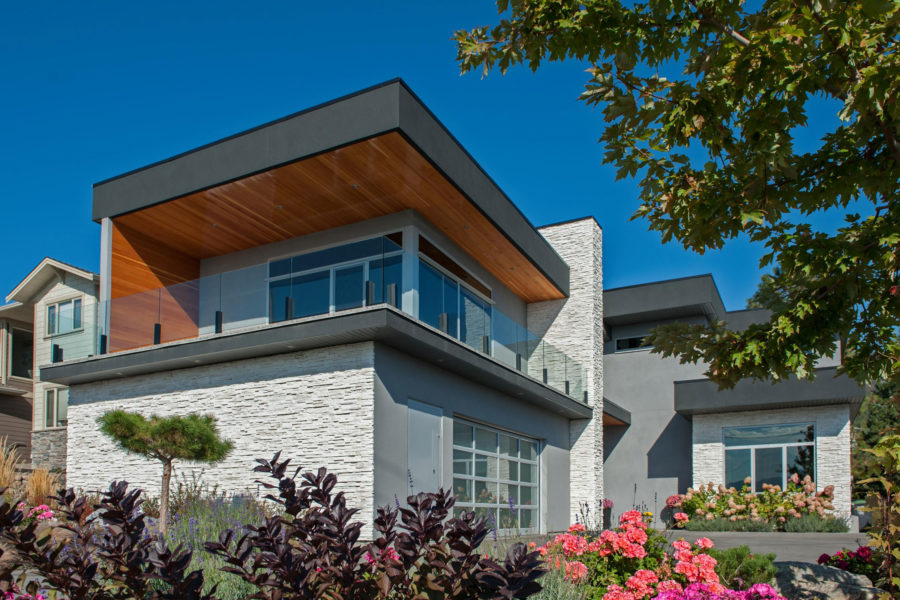
This sophisticated residential facade features a beautiful ledgestone from Cultured Stone. Photo courtesy of Cultured Stone
Aside from the differences in materials and cost, how does natural stone compare to architectural stone veneer? For starters natural stone can be used to construct stairs, flooring, chimneys, and solid, load bearing walls due to its high compression strength and overall durability. When used as a cladding material natural stone offers excellent protection against the elements. However, due to its weight, it requires increased reinforcement.
Pros of Stone
- Long-lasting
- High thermal mass
- Low maintenance
Cons of Stone
- Expensive
- Requires skilled stonemasons
- Lengthy construction process
Architectural stone veneer is a manufactured product designed to mimic the look and texture of natural stone and is used almost exclusively as an exterior cladding. Architectural stone veneer is significantly cheaper and lighter than natural stone, making it possible to install even on non-structural features, but it has nowhere near the same durability and typically only has a lifespan of 50 years.
Pros of Architectural Stone Veneer
- Lightweight
- Easy to install
- Lower upfront costs
Cons of Architectural Stone Veneer
- Susceptible to moisture damage
- Shorter lifespan
- May not be sustainable
Stone Home Designs & Inspiration
While stone traditionally invokes a sense of almost rural antiquity, one associated with, say, the English or Scottish countryside, it needn’t be limited to the architectural styles of the past.
Today’s stone homes reflect both contemporary and antique design elements, proving once more how versatile stone can be. We’ve included some of the most inspiring designs below.
Saint Clair Country Estate, Vancouver
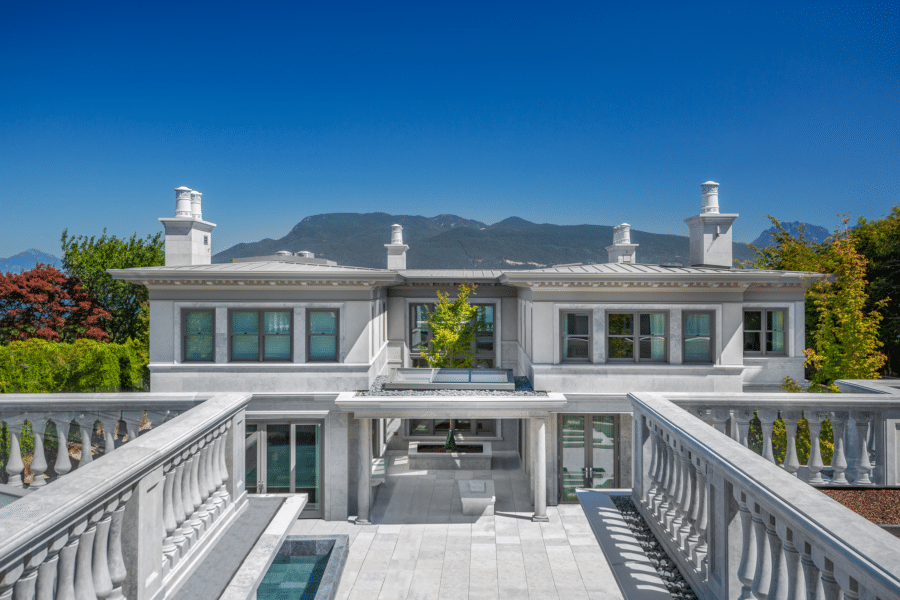
This neoclassical private residence in Vancouver was built with Polycor’s SAINT CLAIR Fleuri Marble from Oklahoma, fabricated and installed by Red Leaf Stone. Photo courtesy of Polycor
Built in the Neoclassical style, the Saint Clair Country Estate is a modern marvel in stonemasonry and a shining example of stone’s elegance as a building material. Completely clad and ornamented in American limestone, this rural mansion takes inspiration from the relative simplicity of classical Greco-Roman designs and is characterized by grandeur of scale, symmetry of form and fenestration, and refined ornamentation.
All of the stone used in the project was supplied by Polycor and sourced from the company’s Marble City, Oklahoma limestone quarry. The dense grey-beige stone—referred to as Saint Clair—sports a wavy grain pattern and is freeze-thaw resistant, making it an excellent choice for projects in the Pacific Northwest.
In total, 60 blocks of Polycor’s Saint Clair limestone went into the project; craftsmen from Red Leaf Group cut, milled, carved, sculpted, and installed the stone over a three-year period, fashioning everything from pavers and pier caps to soffits, railings, and corbels.
Casa Rio, Gondomar, Portugal
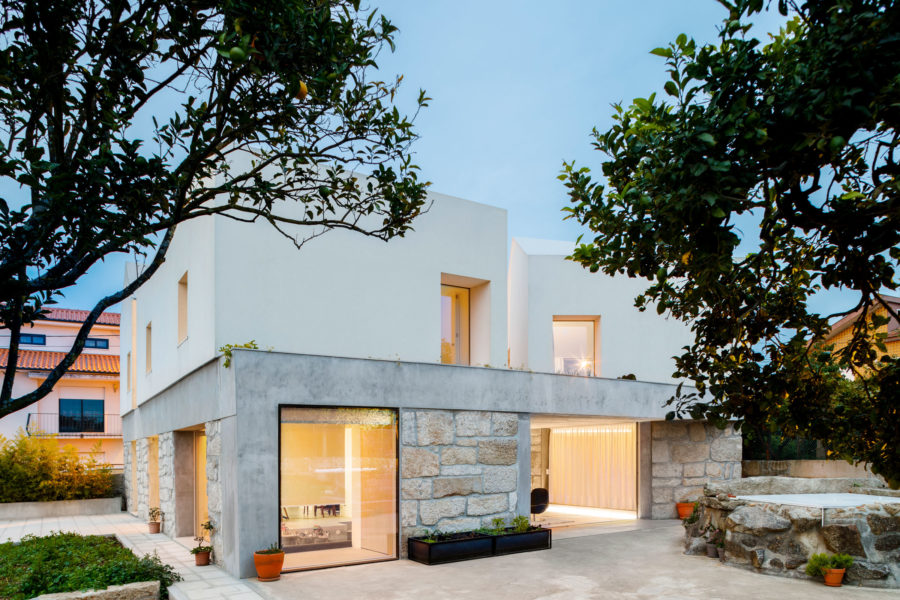
Paulo Merlini Architects reinvented a Portugal farmhouse. Photo by Ivo Tavares Studio
Designed by Paulo Merlini Architects, Casa Rio is another excellent example of how stone can be used to tie new and old architectural styles together. The two-story home consists of a green roof and three gabled volumes perched atop a concrete plinth supported by thick stone walls. Light-colored granite was chosen for the ground floor as both a nod to the region’s vernacular architecture and to help provide contrast against the crisp white of the second floor volumes.
Casa Rio’s contrasting materiality was an extremely intentional choice, serving as a visual reflection of the floors’ different spatial experiences; the ground floor houses a kitchen, sunken lounge, and other communal living areas while the second-floor volumes are more private, playing host to an office, bathroom, and three bedrooms.
Beyond aesthetics the stone walls also help to passively regulate interior temperatures thanks to their high thermal mass. “The most impressive sustainable features of the building are, in our view, the thermal comfort achieved by the thermal inertia of the original granite walls and landscaped roof,” architect Andre Santos Silva previously told gb&d.
Stone House, Minorca, Spain
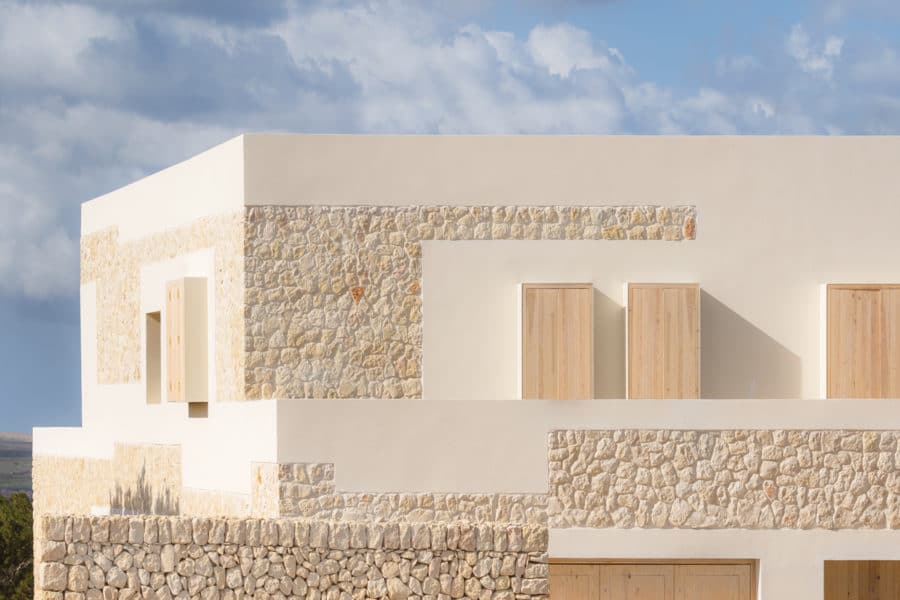
The Stone House features limestone and plaster exterior cladding. Photo courtesy of Joan Guillamat
Constructed by NOMO Studio, the appropriately-named Stone House in Minorca, Spain once again showcases how stone can be combined with other materials—in this case, concrete—to blend old and new architectural styles together.
Designed to emulate the ancient walls and fences found across the island, the Stone House utilizes local limestone collected from the project site to clad its exterior. Light-colored plaster lines the edges of the house’s roof and walls, creating an intermingled patchwork effect with the limestone that hearkens back to traditional Minorcan customs.
Inside the Stone House uses sand-colored concrete to compliment the exterior limestone, pairing it with white-veiled wooden beams, pine carpentry, and whitewashed walls to create a light, airy, and inviting atmosphere.
Punta House, Mexico City
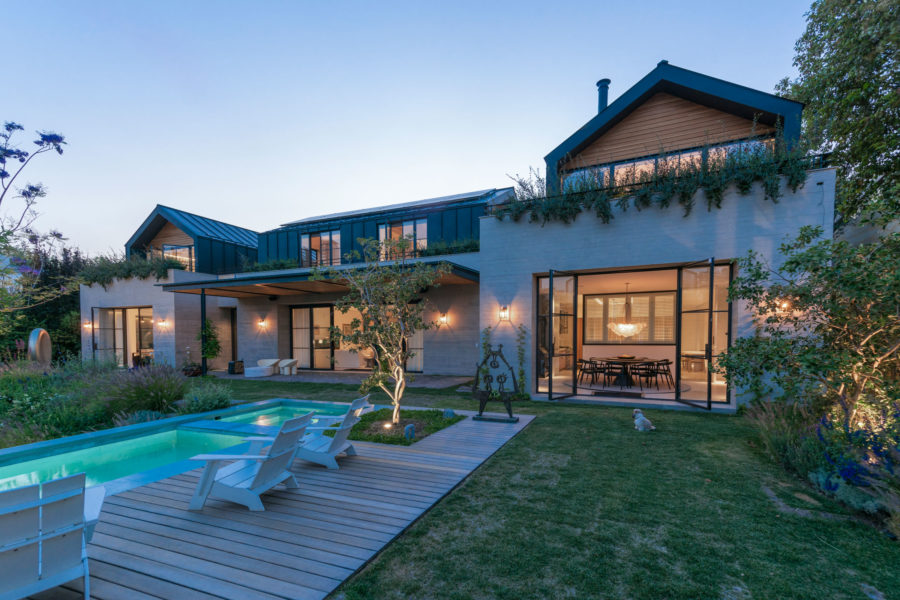
The Punta House, designed by ZD+A and VGS Arquitectos, utilizes marble and volcanic stone in its construction. Photo courtesy of Jaime Navarro
Designed by ZD+A and VGZ Arquitectos, the Punta House in Mexico City blends volcanic stone and marble with wood, concrete, and stucco, mixing traditional and contemporary style preferences to create a sustainable homestead embedded in the natural world.
Like Casa Rio, the Punta House uses building materials to differentiate between spatial experiences and varying levels of privacy. “The materiality distinguishes public and private areas by having a different palette for each grade of privacy: steel and zinc for the private areas, and concrete and stone for the common areas, each level distinguished by its materiality and exterior structuring,” Yuri Zagorin, a founding partner of ZD+A, previously wrote for gb&d.
Marble is used as an accent feature throughout the house, its stately, refined look contrasting nicely with the warm, inviting oak that defines and unifies the interior styling. Outside, volcanic stone covers the service area and clads the foundation, giving the appearance that the house itself is rising out of an ancient lava flow.
Stone Home Lifespan
Well-built stone homes typically last upwards of 100 years, according to the International Association of Certified Home Inspectors. There are, however, certain environmental factors that can prematurely reduce the structural integrity of stone houses, especially if the masonry isn’t properly maintained.
Unsealed stone and deteriorating mortar, for example, can allow water to enter the stone or seep behind it—should this water freeze, it can cause the stone to crack or even shift position. If left unchecked, this can lead to breakage or allow the stone to fall out the wall itself.
Maintenance tips for stone houses include:
- Use a mild detergent to clean stone masonry at least once each year.
- Remove climbing plants like ivy and moisture-retaining mosses from the surface of exterior stone walls to keep the mortar in good condition.
- Unclog weep holes and repair damaged mortar regularly to minimize the chance of debilitating moisture damage.
In general, it’s recommended that homeowners inspect their stone homes annually to mitigate the need for expensive repairs down the line.

